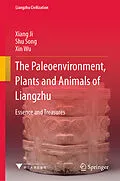Autorentext
Xiang Ji graduated from the School of Earth Sciences and Engineering, Nanjing University. His main research interest is geochemistry, and he has been a researcher at Zhejiang Provincial Institute of Cultural Relics and Archeology since graduation and has participated in research programs concerning the Liangzhu archeological site. His recent papers include A Study on the Properties and Origin of the Stones Used in the Making of Stone Artifacts at Liangzhu Archeological site, Restorartion of the Paleoenvironment outside the Ancient City of Liangzhu, and The Characteristics and Provenance of the Sr-Nd Isotope in the Liangzhu Remains and its Significance on the Extinction of the Ancient Culture.
Shu Song holds a master's degree in Archeozoology from Jilin University. She is a researcher at the Zhejiang Provincial Institute of Cultural Relics and Archeology, where she focuses on studies of animal remains at the Liangzhu archeological site. She has participated in excavation projects at Weijiawopu in Inner Mongolia, Houtaomuga in Jilin, and Hebosuo in Yunan and has published a number of articles, including A Study on the Animal Bone Remains Excavated at Heibei Archeological Site in Wangqing, Jilin, A Study on G1 Animal Bone Remains Discovered at Houtaomuga Archeological Site in Daan, Jilin, and A Summary of the Animial Remains Unearthed at Liangzhu Archeological Site.
Xin Wu is a researcher at Zhejiang Provincial Institute of Cultural Relics and Archeology. She completed her postgraduate studies in Archeobotany at the School of History and Culture, Shandong University. She is responsible for the academic studies on plant remains at the Liangzhu archeological site, and she has also been involved in exploration work at Luhe in Jiaxian county, Guanzhuang in Xingyang county, and Dalaidian in Hebi city, Henan province.
Inhalt
Chapter I Climate and Environment of Liangzhu Site
1. Human and Nature
1.1 Climate and History
1.2 The mysterious 30 degrees north latitude
2. Rise and fall of Liangzhu Culture
2.1 C-shaped area of Liangzhu Culture
2.2 Chinese paradise: Jiangnan
2.3 Prehistoric Power
3. How to study paleoenvironment
3.1 Book of the earth
3.2 Magical chemical elements and isotopes
3.3 Invisible history
Chapter Animal World of Liangzhu Site
1. Zooarchaeology of Liangzhu1.1 What is zooarchaeology?
1.2 Field sampling
1.3 Laboratory work
2. Long misunderstood Liangzhu animals
2.1 Wild boar or domestic pig?
2.2 Bubalus mephistopheles Modern buffalo
2.3 Yellow-spotted giant turtle, Taihu lake turtle, lump-head turtle, Sishi turtle, or spotted turtle?
2.4 Chicken or pheasant?
2.5 Sheep, goat, or Capricornus sumatraensis?
3. Liangzhu people keep up with animals
3.1 See big through small
3.2 From bones to tools
3.3 Animal images (animal images applied to jadeware and other artwork)
Chapter Plant Paradise of Liangzhu Site
1. Emergence of Archaeobotany
2. Archaeobotany of Liangzhu Site
2.1 Rice farming
2.2 Fruit and vegetable cultivation
2.3 Processing and utilization of wood
2.4 Ingenious building materialStraw-wrapped Mud
